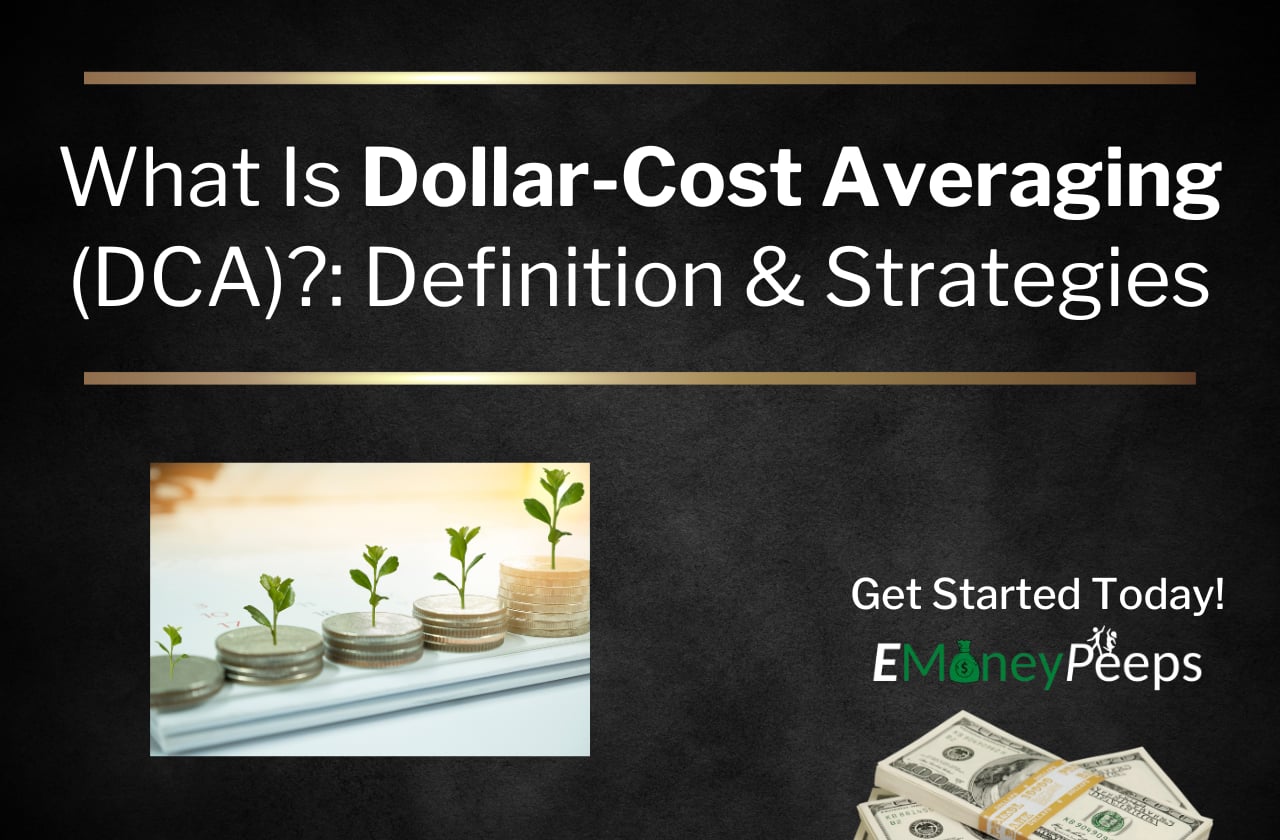What Is Dollar-Cost Averaging (DCA)?: Definition & Strategies

Investing in the stock market can often feel overwhelming, especially for beginners. The constant market fluctuations and the pressure to make the right decisions at the right time can deter people from taking the plunge.
However, there’s a strategy that can simplify the process and make investing more accessible, regardless of market conditions. This strategy is known as Dollar-Cost Averaging (DCA).
It’s a long-term approach to investing that emphasizes consistency, making it an ideal choice for those who want to grow their wealth over time without constantly worrying about market volatility.
In this blog post, we’ll explore what Dollar-Cost Averaging is, how it works, and whether it’s a good strategy for various types of investments like REITs and DRIPs.
We’ll also compare it to other investment approaches and guide you on how to start your journey with DCA.

Dollar-Cost Averaging Definition
Dollar-Cost Averaging (DCA) is an investment strategy that involves investing a fixed amount of money at regular intervals, regardless of the asset’s price.
Instead of investing a lump sum all at once, you commit to buying shares of a particular stock, mutual fund, or ETF over time.
This method spreads your investment across different price points, potentially lowering the average cost per share and reducing the risk associated with market volatility.
For instance, if you decide to invest $200 every month in a particular stock, you will buy more shares when the price is low and fewer shares when the price is high.
Over time, this can average out the cost you pay per share, hence the name “Dollar-Cost Averaging.”
It is a straightforward and disciplined way to invest, especially for those who do not want to worry about market timing.

Understanding How Dollar-Cost Averaging Works
The basic principle behind Dollar-Cost Averaging is simple: instead of trying to guess when the best time to buy a stock is, you spread your purchases over a longer period.
By investing the same amount of money regularly (such as weekly, monthly, or quarterly), you can avoid the pitfalls of market timing and mitigate the risks associated with sudden market downturns.
When the market is down, your regular investment buys more shares because the price is lower. Conversely, when the market is up, your fixed investment buys fewer shares.
This automatic adjustment helps to balance out the cost per share over time, especially during periods of market fluctuation. By not having to decide when to buy, investors can avoid emotional decisions that often lead to buying high and selling low.
Dollar-Cost Averaging is particularly effective for long-term investors because it encourages consistent investing, which can lead to significant returns over time.
However, it’s not a get-rich-quick scheme. The key is to remain patient and stick to your investment plan, even when the market is volatile.
6 Effective Strategies To Recession Proof Your Retirement

Is A DCA Investing Strategy Good For Investing In REITs And DRIPs?
Real Estate Investment Trusts (REITs) and Dividend Reinvestment Plans (DRIPs) are two popular ways for investors to generate passive income.
But how does DCA fit into these investment vehicles?
DCA is an excellent strategy for investing in REITs because it allows you to invest steadily over time. The real estate market can be just as volatile as the stock market, and trying to time your entry can be challenging.
By investing in REITs through a DCA approach, you can average out your costs and avoid overexposure to high-priced shares. This makes it easier to build a diversified real estate portfolio without needing to predict market trends.
Similarly, DRIPs benefit significantly from Dollar-Cost Averaging. With a DRIP, dividends earned from your investments are automatically reinvested to purchase more shares.
This process aligns well with DCA principles because you are consistently reinvesting at different price points. As long as the company continues to pay dividends, you will keep accumulating more shares, further compounding your returns.
In both cases, the DCA strategy can make it easier for investors to accumulate assets and grow wealth over time, while also potentially minimizing the impact of short-term market fluctuations.
Assets I Won’t Put In A Living Trust To Help My Kids Avoid Probate
Example Of Dollar-Cost Averaging
Let’s consider a practical example to illustrate how Dollar-Cost Averaging works.
Imagine you have $1,200 that you want to invest in a particular stock, but you’re not sure if now is the best time to buy.
Instead of investing all $1,200 at once, you decide to use the DCA approach and invest $100 each month over the next year.
In January, the stock price is $50, so you buy 2 shares. In February, the price drops to $40, and you are able to buy 2.5 shares.
In March, the price rises to $60, and you buy 1.67 shares. This process continues for the rest of the year.
By the end of the year, you will have bought shares at various prices, and your average cost per share will be based on all your purchases combined.
The beauty of DCA is that you don’t have to worry about the right time to invest. Whether the stock price is high or low, you continue to invest, potentially lowering your average cost per share over time.
17 Home Businesses You Can Start For $50 Or Less
Does Dollar-Cost Averaging Actually Smart To Do?
The idea behind Dollar-Cost Averaging is to simplify the investing process by spreading your investments over time, but is it really a smart thing to do?
The answer largely depends on your investment goals, time horizon, and risk tolerance.
For beginners or those uncomfortable with market volatility, DCA is a sensible approach because it takes the guesswork out of investing.
It prevents the common mistake of trying to time the market, which often results in buying high and selling low.
Studies have shown that even professional investors struggle to consistently time the market correctly, so for most people, DCA is a safer bet.
On the other hand, if you have a large sum of money ready to invest and the market is on a clear upward trend, a lump-sum investment may yield higher returns.
However, this involves taking on more risk because if the market drops right after your investment, your entire lump sum will be affected.
DCA mitigates this risk by spreading your exposure over a period of time, giving you a better chance of achieving a lower average cost.
How To Use Leverage In Your Life To Get Rich

Dollar-Cost Averaging Versus Lump Sum Investing
The debate between Dollar-Cost Averaging and Lump Sum Investing is ongoing, and each has its own merits.
Lump Sum Investing involves investing all your available funds at once. If the market is trending upwards, lump sum investing can maximize your returns because your entire capital appreciates as the prices rise.
However, Lump Sum Investing also carries a higher risk. If the market crashes shortly after you invest, you could face significant losses.
For this reason, Dollar-Cost Averaging is seen as a more conservative strategy, reducing the impact of short-term market swings and giving investors peace of mind.
By spreading your investment, DCA helps in managing risk and reducing the likelihood of regret if the market dips shortly after a lump sum investment.
Studies have shown that over long periods, Lump Sum Investing can outperform DCA if markets are consistently trending upward.
However, this requires a level of confidence and risk tolerance that not all investors possess. For those who prefer a more balanced, low-stress approach, DCA is often the better choice.
Smart Financial Habits To Build Wealth At Any Age
Market Timing And How It Compares To DCA
Market timing refers to the practice of trying to predict the future movements of the market to buy low and sell high.
While it sounds appealing, market timing is notoriously difficult to execute, even for experienced investors.
There are countless variables that can influence the market, from economic data releases and geopolitical events to changes in company leadership and natural disasters.
The unpredictability makes it nearly impossible to consistently make the right call.
Dollar-Cost Averaging eliminates the need for market timing. Instead of trying to guess when the market will rise or fall, you invest a fixed amount at regular intervals.
This approach not only saves time and reduces stress but also lowers the risk of making poor investment decisions based on emotional reactions to market movements.
How To Build Wealth In Your 50s – The Ultimate Money Guide
Pros And Cons Of Dollar-Cost Averaging
Every investment strategy has its pros and cons, and Dollar-Cost Averaging is no exception. One of the biggest advantages of DCA is that it reduces the risk associated with volatility.
By investing regularly, you are less likely to invest a significant amount of money at a peak price.
DCA also promotes disciplined investing, making it easier to build a habit of saving money and investing regularly.
However, DCA may also limit your returns if the market is on a consistent upward trend. In such cases, a lump-sum investment would likely yield higher returns because your entire capital would be invested from the start, benefiting from the market’s rise.
Additionally, DCA involves more transactions, which can lead to higher fees, depending on your broker.
Who Is Dollar-Cost Averaging For?
Dollar-Cost Averaging is ideal for investors who:
- Want to start investing but are unsure when to begin.
- Have a lower risk tolerance and want to minimize the effects of market volatility.
- Prefer a disciplined, hands-off approach to investing.
- Are long-term investors seeking to build wealth steadily over time.
- Do not have a large sum of money to invest upfront but can commit to investing smaller amounts consistently.
Best Strategies For Building Wealth In Your 20s Fast

How To Start Dollar-Cost Averaging?
Starting with Dollar-Cost Averaging is simple. First, decide on the amount of money you can comfortably invest on a regular basis.
This could be weekly, monthly, or quarterly, depending on your financial situation. Next, choose the assets you want to invest in.
It’s usually a good idea to select diversified assets, such as mutual funds or ETFs, to reduce risk further.
Once you’ve decided on the investment amount and assets, set up an automatic investment plan with your broker.
Many online brokers like Fidelity offer tools to automate this process, allowing you to set it up once, and your investments will be made automatically at the intervals you choose.
This automation ensures that you stick to your investment plan without having to think about it constantly.
Over time, this can lead to a more disciplined approach to saving and investing, which is crucial for building long-term wealth.
It’s also important to review your investment strategy periodically. While Dollar-Cost Averaging works best when left to run its course, checking in periodically can help you ensure that your investment choices still align with your financial goals.
For example, if your income changes or if you find new opportunities in the market, you may want to adjust your DCA contributions.

In Conclusion
Dollar-Cost Averaging is a simple yet effective strategy for investors who want to build wealth over time without the stress of trying to time the market.
By investing a fixed amount at regular intervals, you can lower your average cost per share and reduce the risk associated with short-term market fluctuations.
While it might not always lead to the highest returns compared to a lump-sum investment during a bull market, DCA provides a balanced and disciplined approach that is suitable for long-term investors, especially those with lower risk tolerance.
The key to success with DCA is consistency. It encourages regular investing, making it easier for people to get started in the stock market.
Additionally, DCA works well with various investment vehicles, including REITs and DRIPs, helping investors diversify their portfolios.
Whether you are a beginner or a seasoned investor, Dollar-Cost Averaging can be a smart way to grow your investments steadily over time.
We really hope this article on Dollar-Cost Averaging has been extremely helpful to you.
If you have any questions, don’t hesitate to post them in the comments section below or just say hello.
Sincerely,
Your Friends And Partners
Richard And John Weberg

Copyright Notice: If this content is reproduced in full on any other website other than EmoneyPeeps.com, it is without our permission, and is copyright infringement. We own all rights to this article. Any attempts to infringe the website content will result in strict legal actions. You are free to link to any article on our website, but not copy our content.
FAQs About Dollar-Cost Averaging – DCA
What is the primary advantage of Dollar-Cost Averaging?
The main advantage of DCA is that it reduces the risk of investing a large sum at a potentially unfavorable time. By spreading out your investments, you are less likely to buy at peak prices and can benefit from purchasing more shares when prices are lower.
Can Dollar-Cost Averaging help during a bear market?
Yes, DCA can be particularly beneficial during a bear market. By continuing to invest at regular intervals, you can accumulate more shares at lower prices, which could lead to significant gains when the market eventually recovers.
Is Dollar-Cost Averaging better than a lump sum investment?
It depends on market conditions and your risk tolerance. Lump-sum investing can lead to higher returns if the market is trending upwards, but it also carries a higher risk. DCA spreads out the risk, making it a safer and more conservative approach, especially for beginners.
How do I know if Dollar-Cost Averaging is right for me?
If you are a long-term investor who prefers a simple, disciplined approach and you don’t want to worry about market timing, DCA could be a good strategy for you. It’s also a great option if you are investing smaller amounts over time rather than a large sum upfront.
Are there any downsides to Dollar-Cost Averaging?
The main drawback is that DCA may limit your returns in a consistently rising market, where a lump-sum investment could potentially generate more profit. Additionally, regular investments might lead to higher transaction fees, depending on your brokerage.
Can I use DCA with any type of investment?
DCA works best with investments that are volatile and fluctuate over time, such as stocks, ETFs, and mutual funds. It may not be as effective for assets that have little to no price movement, like certain types of bonds or fixed income securities.
How can I start Dollar-Cost Averaging today?
To begin, decide how much you can afford to invest on a regular basis. Choose the investment vehicle that suits your goals, and set up an automatic investment plan with your brokerage. Many online brokers offer features that allow you to automate your investments, making the process hassle-free.


